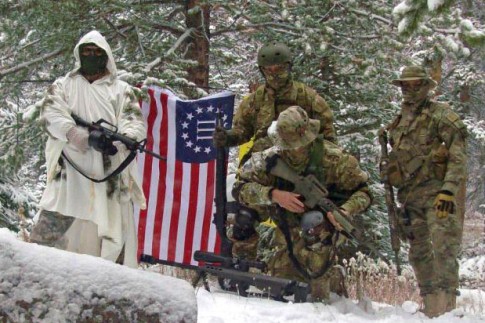To Protect and Serve

A couple of randomesque news items today that are not so random as all that.
First, a community activist in Ft Myers, Florida, was arrested for stepping into the street to sidestep a pile of debris blocking the walkway. The whole thing stinks, it was clearly a lo-grade harassment bust, and the guy will no doubt get off. But not until he has to appear in court, hire a lawyer, etc. We can be certain that Joshua McKnight did not catch this shakedown because he was a Black man who just happened to be well known to five-oh due to his constant video recording of police activity in his neighborhood. Perish the thought. The officer was simply citing this scofflaw for obstructing the duties of a police officer who was trying to execute an lawful stop for a non-crime. After all, explained the supervising officer:
…anytime an officer conducts a lawful stop that it’s the law to obey every command an officer gives you.
Even if that lawful stop wasn’t really. Lawful, that is.
Then on NPR today, a discussion about municipalities that are jailing people for failure to pay simple fines, and then charging a daily fee for their incarceration, leading to prisoners amassing enormous debt with no way to pay. (This was one factor in the post-shooting unrest in Ferguson and elsewhere last year.) This is our version of Dickens’ debtor prisons. No different, really. People with no resources are penalized for having no resources, then penalized further for having no resources. Never mind the people held on flimsy charges who cannot afford bail who are then assessed for their food and lodging. It’s like a Kafka nightmare after an ibogaine binge.
And let’s not even get started in the asset forfeiture plague, a form of legalized gangsterism under the banner of fighting the war on drugs. And frankly, thinking about the rash of police homicides and the way they are covered up and excused (and the citizenry that helps excuse them) fills me with a more-than-exhausting sense of despair. Let’s forget I said anything.
Also yesterday, an article about a chemist in a Massachusetts State Police drug lab:
Investigators for the attorney general’s office found that chemist Sonja Farak had tested drug samples or testified in court between about 2005 and 2013 while under the influence of meth, ketamine, cocaine, LSD, and other drugs…

On top of that, she was stealing cocaine from the evidence locker and cooking crack IN THE FREAKING STATE DRUG LAB.
She also used many other reference drugs, she testified, and consumed her coworkers’ samples, as well as samples police brought in as evidence. When cocaine samples coming into the lab dwindled, she testified, she began doing crack cocaine. She cooked it in the lab after hours starting in 2012, she testified. She used crack throughout the building and at her work station, she said — even when other employees were at the lab.
There was evidence as far back as 2013 that Farak was Lebowski-ing her way through the workday, but since she was pretty efficient at helping put away the bad guys it must have been easier to turn a blind eye. Thousands of convictions based on the testimony of a chemist who was tripping balls. But justice is served! She got 18 months.<fn>Simple possession in Mass. calls for a one-year minimum; possession with intent to sell, minimum 5 years. Reckon she was cooking for personal use only.</fn>
<fn>N.B. This case follows on the case of chemist Annie Dookhan, also of Massachusetts, who was convicted of essentially writing up lab results the way the police wanted, often never even bothering to run a test on a substance at all. As with Farak, her let-us-say lax standards were well known among the prosecuting community, but her effectiveness at putting baddies in the hoosegow made her a popular and highly productive employee all the same.</fn>
But it’s not just crusaders in the war on drugs and certain people who use them that enjoy a little leeway.<fn>For the sake of sanity and blood pressure, we’ll skip over the criminals of the Crash of ’08, the torture enthusiasts of our waronterror, &c. I’m trying to cut down on my drinking.</fn> Flash back to March, 2014, and enjoy the sight of law-abiding citizens aiming their rifles at Federal employees at the Bundy ranch in Nevada.

The Feds backed down. Didn’t want to cause too much trouble. Scoot ahead to January, 2016, when the Bundy spawn decided to occupy a Federal facility in Oregon.

Eventually, this became too much to bear, and the Feds dropped on these bunch of misfits and deadbeats, killing one and sending many others away for what is likely to be a very long stretch. But really, it took the Feds two years to move on them, a decision that likely cost the taxpayers millions of dollars in law enforcement costs and damage to the Malheur Wildlife Refuge, not to mention the ongoing refusal to pay the millions in back fees and taxes owed by Bundy that started the whole mishigas in the first place.
I’m not saying the Bundy’s needed to meet the same fate as Koresh or the Ruby Ridge loonies. But it is more than passing strange that a Michael Brown or Eric Garner will find themselves dead in the blink of an eye while people like the domestic terrorists of the Bundy Gang<fn>Whose crimes on the monetary scale alone are exponentially greater, never mind the implicit threat of violence that far exceeded any threat represented by Garner/Brown/et al.</fn> managed to skate for nearly two years and were only arrested after a ridiculous escalation of destruction and threat of violence.
And certainly, one would be cynical to think that the tacit support offered the domestic terrorists by allegedly responsible people like state and federal legislators, media organizations, and even the occasional Presidential candidate was anything but sincere and well-considered. Certainly there was nothing cynical about offering support to this gaggle of goofballs, and I’m sure it had nothing to do with scoring points among the rubes and marks of Idiot America.

But as with the ongoing reality show starring T-rump, if someone gets a microphone often enough and repeats borderline-psychotic rantings often enough – under the guise of patriotism or defending the Constitution – we the people are expected to demonstrate “tolerance” and “respect” for the wide range of thought and belief in our polity. You might even – as did Nevada Congressional Candidate and Friend of the Bundys – announce that if any law enforcement officer pointed a weapon at her she would not hesitate to start firing.

Unsettled in our understanding of our justice system is confusion over whether the police are supposed to “protect and serve” versus conduct “law enforcement”. And maybe the distinction is not that important, though I do think emphasizing service over “force” might be a good place to begin.
But it certainly goes deeper than that, and like too many other problems facing our society, finds its roots in our Original Sin of slavery and the ongoing attempts to maintain whatever octane of racial and social purity prevails at any given moment. That Eric Garner can die in a minute while wannabe Rambos point automatic weapons at Federal cops paints the ugly truth in a way few people want to acknowledge. That too many people can see Tamir Rice as an obviously dangerous threat while Cliven Bundy can foment an armed standoff with the police and be seen as a patriot.<fn>I’m certain there are mis-apprehensions among people on “my side” that are equally egregious. Mea culpa.</fn>
I got no answers, just a bundle of aggravating threads of misbehavior that lead to more stories of frustration. And, to be fair, more than a few awful stories about police who are killed in the line of duty. And to be further fair, more than a few stories about police who go way out of their way to truly protect and serve.
This isn’t an anti-cop rant. More than anything, it’s a rant at the separations and divisions that slice our nation up into littler and littler pieces. And I don’t see it getting better. There are too many ‘leaders’ who correctly understand the effectiveness of stoking the resentments and fanning the flames. It won’t stop, no matter who controls the White House or the state house.
As Trump said today: “You win the pennant and now you’re in the World Series — you gonna change?”
Until we get serious as a society about refusing to pretend that people like Fiore or Trump are actually responsible members of society, worthy of holding elected office, this madness will continue.
Whaddya gonna do?




